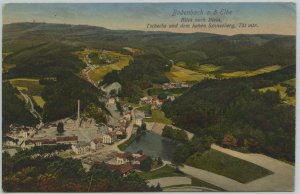
Bela´s view (Bělská vyhlídka)

| Popis |
The westernmost promontory of the Shepherd's Wall bears the Bělská vyhlídka lookout point and provides a view of several neighboring villages. The first of them is the village of Bělá (until 1949 a separate village, today the urban district of Děčín X - Bělá), which was probably founded after the Hussite wars and was first mentioned in writing in 1454. Only the lower part, called Stará Bělá, can be seen from Bělská vyhlídka while the slightly higher Nová Bělá with the church is hidden behind the wooded ridge separating Běla and Bohemia. The lower part of Stará Bělá is dominated by the Terezín Pond built by Count František Antonín Thun in 1835 for the supply of the Terezín mill and the sawmill under the dam. The area was named after the founder's wife, Countess Theresia n. Brühl. The sawmill at the Terezín Mill was a part of the whole network of saws built in the wooded parts of the Děčín estate so that they could process the harvested wood without unnecessary transport. The wood was processed not only for fuel but also for building material for whole houses or their substantial parts. Cutting logs for beams, planks and battens required constant water power, which only the chateau sawmill in Děčín disposed of, powered by water from the chateau pond. Other mansions in the manor lay on unstable water and could only work for a part of the year. The Terezín mill with a sawmill lay on the permanent water from the pond and became the second sawmill in the manor with the possibility of year-round operation. Its premises remained basically preserved until demolition and reconstruction at the beginning of the 21st century. On the opposite slope, which is now wooded, there used to be a large brickworks with steam drive and circular furnaces. In 1910/11 it was built by Friedrich Arlt, whose family used to produce bricks and decorative ceramics at house no. 14 in Bělá. Julius Dressler also produced faience and siderolite in Bela since 1883. Another settlement well visible from the Bělská vyhlídka is the village of Čechy, now the urban district of Děčín XIX - Bohemia. Its origins are associated with the mining of ironworks in the local sandstones, which began sometime after 1570. In the written sources from the 16th and 17th centuries, the settlement is referred to as Zschechen or "Auf der Zeche", ie "On the Down". From this word came the later name Tscheche, from Czech translated as Bohemia. In 1787 the settlement had only 9 houses and in 1833 10. By 1883, the number had increased to 17. The development of the settlement began at the end of the 19th century, when the first family houses began to grow in its lower part. There were already 30 houses in 1900 and their number increased to 378 in the Second World War. After 1990, Bohemia became a lucrative place for building family houses. Most of the former farmland was built in the settlement, new streets were set up and today there are approximately 70 houses. In the western direction of the Jílov Valley, the town district of Horní Oldřichov is well visible from Bělská vyhlídka. It is a relatively young settlement founded in 1737 on the parcels of the former Bynovský Court. The settlement gained the attribute "upper" to distinguish it from the older village Oldřichov (later Dolní Oldřichov - Nieder-Ullgersdorf), which was established in the Jílové valley after the Hussite wars. Horní Oldřichov was initially called Neu-Ullgersdorf (ie New Oldřichov) or Trabantendörfel. In 1787 there were 17 houses and in 1833 40 with 258 inhabitants, who, due to the lack of agricultural land, made their living mainly by denigration and home spinning. |




